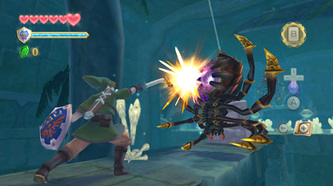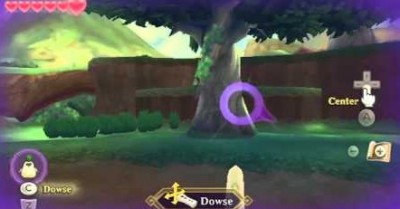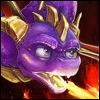Skyward Sword’s Controls: Setting Things in Motion
Posted on December 21 2012 by Mases Hagopian
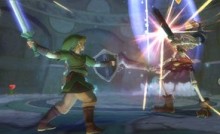 Over a year ago, the latest Zelda title, Skyward Sword, was finally released after a development period of three or four years. It’s the first Zelda game to utilize the player’s movement as a means of controlling Link. Before the introduction of this novel gameplay feature, the fans would simply press buttons to get a desired result, but now they are in direct command of Link’s actions. This article focuses on the many new aspects that the motion controls presented — along with the game’s other control innovations — and their upsides and downsides.
Over a year ago, the latest Zelda title, Skyward Sword, was finally released after a development period of three or four years. It’s the first Zelda game to utilize the player’s movement as a means of controlling Link. Before the introduction of this novel gameplay feature, the fans would simply press buttons to get a desired result, but now they are in direct command of Link’s actions. This article focuses on the many new aspects that the motion controls presented — along with the game’s other control innovations — and their upsides and downsides.
I love that Nintendo decided to go with the Wii MotionPlus attachment as the main focus of Skyward Sword’s controls. It stimulates an invigorating and immersive experience for the player, pulling them deeper into the action and the adventure that constitutes the Zelda series. As I mentioned above, we’re no longer pressing buttons to perform a programmed move — we cause Link’s actions with our own movement. Whenever I swing my Wiimote, Link follows suit with his sword, and it feels as if I really am the one controlling his actions. This connection between the game and the player is naturally limited to the upper-torso the majority of the time; when Link runs, we’re not jogging in place or dashing toward the screen (which would have been aggravating). We only have to press a button for that, and that’s for the better.
Since not all of Skyward Sword’s controls are based on the player’s movements, it introduced a few new features to the more traditional controls as well. These added touches push the player to take a little more time and care during combat and other gameplay sections. We have the Skyward Strike, which after charging, sends a revolving beam into an enemy or switch. The Stamina Meter (or Air Gauge if underwater) is another one, which affects movement because it causes Link to go kaput if he overexerts himself. Running, rolling, or using too many Spin Attacks all at once will make the gauge drop exponentially, possibly putting him in jeopardy. So in this particular game, danger can manifest through the player’s actions.
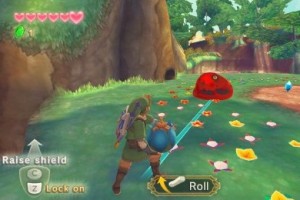 On top of the basic control scheme and set of abilities, Skyward Sword of course has a varied arsenal of distinct items, and with wide use of them throughout the game. Unlike items from previous games, which you used with the buttons and control stick, the weapons of Skyward Sword are controlled by the movement of the Wiimote. The movement might be a simple swipe, such as those of the Bug Net or Whip, aiming at the screen, with items like the Bow or Clawshots, or more specific motions; flinging bombs requires overhand swings to throw and underhand swings to roll.
On top of the basic control scheme and set of abilities, Skyward Sword of course has a varied arsenal of distinct items, and with wide use of them throughout the game. Unlike items from previous games, which you used with the buttons and control stick, the weapons of Skyward Sword are controlled by the movement of the Wiimote. The movement might be a simple swipe, such as those of the Bug Net or Whip, aiming at the screen, with items like the Bow or Clawshots, or more specific motions; flinging bombs requires overhand swings to throw and underhand swings to roll.
For me, pointing to aim is often quicker and way more fluid than tilting the analog stick, and like I have said, it helps bring the game to life. Aside from holding a button down to activate the ranged items, the aiming is completely based on the player’s movement. It makes the items very intuitive, making it feel like you’re really aiming them, while building challenge in puzzles and combat. Some of these were as simple as using the Gust Bellow to uncover a switch buried beneath the sand, but in a more engaging example, the player is found sniping enemies from afar before they can be detected. My only gripe with the aiming controls is that it consistently took the aiming reticule a second or two to catch up with my movement. In a fast-paced battle using the Bow, such as with Tentalus, I need to act quickly, and a delay like this can thwart my progress quite a bit.
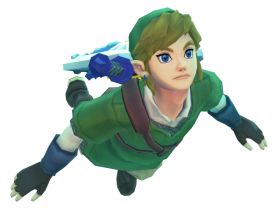 There are a few moments where MotionPlus also controls the direction Link moves, departing from the traditional control-stick navigation the game uses most of the time. During these moments, tilting the Wiimote replaces the control stick and steers Link around in the water (which hearkens back to the swimming abilities of Zora Link from Majora’s Mask or the Zora Armor from Twilight Princess), and doing the same during other moments will steer your Loftwing in the Sky, aim your descent as you freefall, and help you navigate with your flying Beetle contraption. Shaking the Nunchuk will cause Link to blast forward, doing a spin attack underwater or in the Sky, and shaking the Wiimote makes the Loftwing flap to gain altitude. So long as there isn’t interference outside the game, such as the Wiimote pointing slightly the wrong way, a dysfunctional MotionPlus attachment, or wireless interference, all of these maneuvers control seamlessly. There are a few times when a button has to be pressed — to have the Loftwing perform a speed boost, for example — but there’s no way every action could have been mapped to the motion controls, and the mixture of input types doesn’t make these controls bad.
There are a few moments where MotionPlus also controls the direction Link moves, departing from the traditional control-stick navigation the game uses most of the time. During these moments, tilting the Wiimote replaces the control stick and steers Link around in the water (which hearkens back to the swimming abilities of Zora Link from Majora’s Mask or the Zora Armor from Twilight Princess), and doing the same during other moments will steer your Loftwing in the Sky, aim your descent as you freefall, and help you navigate with your flying Beetle contraption. Shaking the Nunchuk will cause Link to blast forward, doing a spin attack underwater or in the Sky, and shaking the Wiimote makes the Loftwing flap to gain altitude. So long as there isn’t interference outside the game, such as the Wiimote pointing slightly the wrong way, a dysfunctional MotionPlus attachment, or wireless interference, all of these maneuvers control seamlessly. There are a few times when a button has to be pressed — to have the Loftwing perform a speed boost, for example — but there’s no way every action could have been mapped to the motion controls, and the mixture of input types doesn’t make these controls bad.
Finally, swordplay is the most-emphasized aspect of combat in Skyward Sword, and as a result is the biggest focus of Skyward Sword’s control innovation. Due to the intelligent nature of the game’s adversaries, the player ought to find it much harder to land a blow on an enemy than in previous games because they’re constantly parrying and moving around, while looking for an opening in Link’s defense.
The opponents of previous games would almost always leave themselves open without even attempting to ward Link’s blade away. But the MotionPlus makes it possible for them to block attacks from nearly all sides while the player has to target their weaknesses. Needless to say, this made clashes with the game’s foes very engaging, and oftentimes difficult to overcome very quickly. Flailing the sword around wildly seldom gets you anywhere in Skyward Sword, as most of the enemies have some sort of shield or other protection. The player needs to watch and react quickly enough if they want to strike during an opening. For foes such as Stalfos or Bokoblins, though they change their blocking stance quite frequently, the player simply has to be aware of the undefended side. Harder foes — Lizalfos and Moblins come to mind — carry huge shields that cover the majority of their bodies, so Link has to wait for them to drop their defenses or get around them and attack from behind. Some enemies don’t wear protection but rather have specific weak points that must be slashed (Beamos and Sentrobes), while others are easily slain by simple sword strokes (Chuchus and Keese). Most of the time, though, an adversary will be carrying a sword, and Link must mind how they block.
Outside of combat, the sword becomes part of a number of other useful features. The aforementioned Skyward Strike is one of them, as it activates Goddess Cubes and Goddess Crests. In my opinion, the Strike is underused in terms of puzzle-solving, but the sword itself still has multiple uses. There are doors locked by eyeballs, that can only be opened by “befuddling” the eye with the sword (similar to “Mr. I” from Super Mario 64). Additionally, combination locks can be found on doors in some dungeons, and may only be opened if the sword knocks the “dials” in the right pattern. However, I believe that the most crucial element of the sword is the brand-new feature appropriately labeled Dowsing. In the game, the player points the sword, using it as a homing device to detect your Dowsing target, beeping to tell the player if they’re on the right path. Dowsing itself is almost like a puzzle, and encourages exploration by allowing the player to select from a wheel of different options (hearts, Goddess Cubes, upgrading materials, etc.) as the game progresses and go in search of them.
Now we delve into some of the rougher aspects of Wii MotionPlus. For a great deal of the time, the motion controls work great and are extremely responsive. But in my experience, too much movement all at once could produce a “confusion” in the calibration. This would cause the game to pause itself in order to recalibrate and then continue where it left off. Personally, I encountered this more than I would like, but looking back I can understand why. It’s because of the immense level of gameplay and interaction in Skyward Sword; during some really intense moments, it is easy to get carried away and start whipping the Wiimote around like a madman (something Mr. McShea would relate to) until the game can’t properly pick up the signal. Compared to, say, Wii Sports, Skyward Sword is not some casual title that people could sit back and play nonchalantly the entire time. Literally the only time I could truly relax while on the move was flying the Loftwing. The rest of the time I was continuously active, fighting foes, dodging rolling boulders, running from one point to another, etc. Skyward Sword, in this sense, lends me the feeling that I am a part of the adventure and have to be lively every minute of it, another thing that the motion controls contribute drastically to.
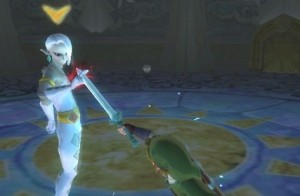 In addition to all that, because the Wii MotionPlus is so immersive, it’s also prone to placing the player under mental duress, which could affect the hand that operates the Wiimote. Take all of The Imprisoned’s battles, for example. After breaking free from his seal, this enormous menace makes his way toward the Sealed Temple. Link is charged with stopping him before he reaches the Temple, and does so by slashing off all his toes to make him fall backwards or by leaping on his head to attack him from there. The player thinks and acts more quickly during these parts in light of a pressure that Zelda fans typically don’t experience. During these hectic moments it is possible to swing the Wiimote with so much force that it throws off the calibration. Perhaps this even causes the player’s swings to outpace the responsiveness of the motion sensor, like I brought up in relation to aiming ranged weapons (though thankfully, that issue can be resolved with the push of a button to center the pointer once again). At any rate, whenever the controls go haywire, it may very well be the player’s movement that causes the need to recalibrate. But the game contains moments of complete urgency, and they are partially to blame for the fact that the player feels rushed at times.
In addition to all that, because the Wii MotionPlus is so immersive, it’s also prone to placing the player under mental duress, which could affect the hand that operates the Wiimote. Take all of The Imprisoned’s battles, for example. After breaking free from his seal, this enormous menace makes his way toward the Sealed Temple. Link is charged with stopping him before he reaches the Temple, and does so by slashing off all his toes to make him fall backwards or by leaping on his head to attack him from there. The player thinks and acts more quickly during these parts in light of a pressure that Zelda fans typically don’t experience. During these hectic moments it is possible to swing the Wiimote with so much force that it throws off the calibration. Perhaps this even causes the player’s swings to outpace the responsiveness of the motion sensor, like I brought up in relation to aiming ranged weapons (though thankfully, that issue can be resolved with the push of a button to center the pointer once again). At any rate, whenever the controls go haywire, it may very well be the player’s movement that causes the need to recalibrate. But the game contains moments of complete urgency, and they are partially to blame for the fact that the player feels rushed at times.
So no, Wii MotionPlus is not perfect at this time; it has its flaws. But motion controls can be expanded on and improved in the future. They weren’t especially “bad” in any manner, except when the game abruptly stopped to recalibrate. The swordplay and item-wielding flow smoothly with the player’s movements, however. Motion controls in Zelda have already been developed to a nearly perfected degree in terms of prompt responsiveness, and while there are issues, which I’ve highlighted, they are minimal when compared to the extensive playtime of Skyward Sword. I just look forward to what Nintendo can do with them in the future, if they choose to use them again, and hope that a new method is made to further ensure that no problems occur.
With all that said, I now leave the spotlight to you, faithful reader. Tell me your thoughts on this topic in the comments below!



